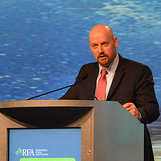The United States Department of Agriculture (USDA) has selected 36 energy facilities in 14 states to accept biomass deliveries as part of the Biomass Crop Assistance Program (BCAP). Biomass owners who supply these bioenergy facilities may qualify for BCAP delivery assistance beginning July 28, 2014. BCAP was reauthorized in the 2014 Farm Bill.
 Of the total $25 million per year authorized for BCAP, up to 50 percent ($12.5 million) is available each year to assist biomass owners with the cost of delivery of agricultural or forest residues for energy generation. Some BCAP payments will target the removal of dead or diseased trees from National Forests and Bureau of Land Management public lands for renewable energy, which reduces the risk of forest fire.
Of the total $25 million per year authorized for BCAP, up to 50 percent ($12.5 million) is available each year to assist biomass owners with the cost of delivery of agricultural or forest residues for energy generation. Some BCAP payments will target the removal of dead or diseased trees from National Forests and Bureau of Land Management public lands for renewable energy, which reduces the risk of forest fire.
“This program generates clean energy from biomass, reduces the threat of fires by removing dead or diseased trees from public forest lands, and invests in rural businesses and new energy markets,” said Tom Vilsack, USDA ag secretary. “The fires we are seeing right now in the west underscore the need for forest restoration and fire prevention. Pairing this effort with forest restoration on public lands will help guard against these fires while promoting economic opportunity for rural communities.”
Farmers, ranchers or foresters who harvest and deliver forest or agricultural residues to a BCAP-qualified energy facility may be eligible for financial assistance for deliveries. The USDA Farm Service Agency (FSA), which administers BCAP, will begin accepting applications from biomass owners from July 28 through Aug. 25. Deliveries of residues for approved contracts may be made through Sept. 26, 2014.


 ystem is indispensable for alternative energy research aiming to create artificial photosynthesis.”
ystem is indispensable for alternative energy research aiming to create artificial photosynthesis.”






